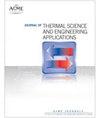Improving turbine endwall overall cooling effectiveness using curtain cooling and redistributed film-hole layouts: an experimental and computational study
IF 1.4
4区 工程技术
Q3 ENGINEERING, MECHANICAL
引用次数: 0
Abstract
To enhance the cooling deficiency that occurs in a baseline endwall using axially-arranged cooling holes, this paper proposes a new locally-enhanced hole layout using curtain cooling and fan-shaped film holes being arranged on iso-Mach lines. The objective of cooling hole re-design is to minimize secondary flows and thus to provide better film coverage. In experiments, Infrared thermography techniques are applied to validate overall cooling effectiveness of the newly-designed endwall, and aero-thermal fields at the cascade exit are detected by five-hole and thermocouple probes. Additionally, computational fluid dynamic simulations are performed to provide complementary flow insights. A comparison with the baseline hole layout reveals that for a given total coolant flow rate, the newly-designed endwall significantly improves the cooling performance by up to 27% without a noticeable aerodynamic penalty, resulting in a lower and more uniform temperature field. Curtain coolant effectively suppresses the development of horseshoe vortex and provides adequate thermal protection for leading-edge junctures and pressure-side corner regions. The redistribution of fan-shaped film holes reinforces the cooling performance in the passage throat and trailing edge regions. At low and high total mass flow rates, the coolant split between various cooling sources has a substantial impact on cooling performance.利用帘式冷却和重新分布式膜孔布局提高涡轮机端壁整体冷却效果:实验和计算研究
为了改善轴向排列的冷却孔在基线端壁中出现的冷却缺陷,本文提出了一种新的局部增强型冷却孔布局,使用帘式冷却和扇形薄膜孔,并将其排列在等马赫线上。冷却孔重新设计的目的是尽量减少二次流动,从而提供更好的薄膜覆盖。在实验中,应用红外热成像技术验证了新设计的端壁的整体冷却效果,并通过五孔探头和热电偶探头检测了级联出口处的气动热场。此外,还进行了计算流体动力学模拟,以提供补充的流动见解。与基线孔布局的比较显示,在给定的冷却剂总流速下,新设计的端壁可显著提高冷却性能达 27%,而不会造成明显的空气动力损失,从而产生更低且更均匀的温度场。帘式冷却剂可有效抑制马蹄涡的形成,并为前缘连接处和压力侧转角区域提供充分的热保护。扇形膜孔的重新分布加强了通道喉部和后缘区域的冷却性能。在总质量流量较低和较高的情况下,不同冷却源之间的冷却剂分配对冷却性能有很大影响。
本文章由计算机程序翻译,如有差异,请以英文原文为准。
求助全文
约1分钟内获得全文
求助全文
来源期刊

Journal of Thermal Science and Engineering Applications
THERMODYNAMICSENGINEERING, MECHANICAL -ENGINEERING, MECHANICAL
CiteScore
3.60
自引率
9.50%
发文量
120
期刊介绍:
Applications in: Aerospace systems; Gas turbines; Biotechnology; Defense systems; Electronic and photonic equipment; Energy systems; Manufacturing; Refrigeration and air conditioning; Homeland security systems; Micro- and nanoscale devices; Petrochemical processing; Medical systems; Energy efficiency; Sustainability; Solar systems; Combustion systems
 求助内容:
求助内容: 应助结果提醒方式:
应助结果提醒方式:


